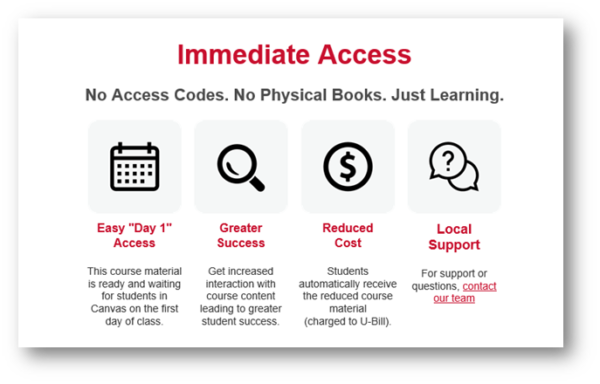Course Materials Disruption

The textbook industry has evolved quickly over the past 10-15 years. In fact, it’s been more than just an evolution, it’s been a full-fledged disruption. And it’s turned out to be more than just the enhancements in technology and digital. It really exposed the issue of textbook pricing. From the bookstore industry side, we have been well aware of this problem. We have been challenging stakeholders for over 20+ years in addition to partnering with used book companies in an effort to combat the textbook pricing problems. Alongside the print-to-digital disruption, there was something much bigger happening at the same time. The internet boom, Amazon, smartphones, new ways of teaching and learning, among other things left exposed the barriers and hardships of students more than ever. The current course materials disruption has ushered in the future we were told about.
Alignment
Again, we knew the barrier existed, but it was very much amplified through this disruption. Issues of access and affordability became personal, not just business and economics. The college bookstore is the business and economics – holding the role that is coordinating this ecosystem between faculty, publishers, and students. Suddenly, our textbook problem aligns with other higher education issues on campus – tuition, housing, food, etc. We now realize we have a common denominator on campus regarding affordable education. It has the attention of all parties – student affairs, finance, and academics. We have gotten down to the root issue, and the ecosystem of partners must work together to provide solutions.
Iowa State University
Iowa State University’s inclusive access program is called Immediate Access. Since the program’s inception 10 years ago in 2012, Iowa State students have saved $15M+ compared to the print textbook (in the early years) and market digital pricing (in recent years). This is money that has gone directly into the hands of students. The money is not going to the central fund or a scholarship fund that is for a select few. It’s money that impacts the entire student body. It’s holistically inclusive.
Distribution
Today’s course materials distribution is so different, yet still so the same. Fundamentally, we still collect adoptions from faculty and still sell textbooks to students, but how we do it has changed. We are meeting the students where they are, rather than having the students come to us. The transaction is now an experience. Reading is now learning. Access can be limitless. There is beauty in the disruption. Age-old problems finally have a long-term solution and impact – removing barriers and giving students the opportunity to thrive, not just survive:
- Providing access on Day 1 of class with digital content – powered by robust, modernized technology
- Providing affordable pricing with collaborative, negotiated programs to impact all students (not just those in specific courses or based on student financial status)
- Providing convenience by pairing the experience with the Learning Management System and comparable experience as other content consumption (i.e. music, TV streaming)
- Providing content in an environment conducive to adaptable learning and knowledge retention
Additional Thoughts
I was fortunate to attend the Textbook Affordability Conference back in 2019 at the University of Minnesota. This is where I first met Phil Hill, a higher education consultant that studies the industry, and he gave a presentation that really summarized this space visually. This visual (Satir Change Model) is from his presentation – it shows this disruption in the textbook industry. The disruption that they kept saying over and over was in 10 years everything will switch from print to digital. Those 10 years would come and go, then 5 years, and another… well here we are experiencing it, right now. Every university or college is experiencing this on their own timeline. But overall, this is a good representation of what the textbook industry has looked like for the past 10-15 years.
The foreign element signified as the digital movement – IA, OER, even textbook rental (which was popularized around 2009-2010ish). In my opinion, we as an industry are moving into the late stages of chaos, and more into integration. This means there is less print in the market because publishers have stopped producing as many physical books. In partnership with publishers, faculty, and bookstores we have made a big dent in solving the issue of textbook pricing by collaborating, innovating, negotiating, and distributing in different ways. With both OER and publisher IA/EA programs. Multiple voices in this space advocating for affordability is a powerful thing. The buy-in and collaboration of all parties – faculty, students, and the support roles such as the library and the bookstore – is what makes the overall affordability initiative successful. This space is not a one-size-fits all approach. It’s not OER or IA, it’s OER and IA.
Bio
Heather Dean is an experienced professional and influencer in the college store and course materials industry. She is the Assistant Director for the Iowa State University Book Store, serving over 14 years in the course materials industry at her alma mater. Her entrepreneurial vision and spirit for innovation have led Iowa State to successfully implement and maintain major course material affordability initiatives over the years. This includes Inclusive Access digital course materials, textbook rental, and the infusion of development of collaborative partnerships with key academic stakeholder on campus. Iowa State was awarded ICBA’s Excellence in Course Materials Management in 2016, 2017, 2018 and the MVP award in 2013 and 2016. Heather has served nationally for the Independent College Bookstore Association (ICBA) on the Board of Directors, ICBA Ambassador, and Course Materials Institute Coach & Presenter. She also serves on various advisory councils with industry partners and across campus at Iowa State. Born and raised in Iowa, Heather is an avid Cyclone football fan and baseball mom.



